Most people I talk to assume that Candomble is the Lukumi or Yoruba religion of Brazil.
This is not true, in Brasil, there is Candomble Ketu (Yoruba), Candomble Jeje (Fon), Candomble Bantu and Candomble de Caboclo (some people would not include this one under Candomble, but I do.)
Now, these ethnic categories are not the best descriptors, since there are elements of the Yoruba, Fon, Bantu and even Ashanti, Ewe and so on in all of the different types of Candomble. Thus, none of these Candomble types are a monolith.
(By the way, some of the pictures do not correspond to the Nkisi but I like the pics. Makes the thread more lively, I would say.)
Moving on.
Candomble Bantu or Candomble de Angola.
The Bantu peoples who were brought to Brazil spoke several languages, especially the Kikongo language, spoken in the Congo, Cabinda and Angola, the Kimbundu language, spoken in Angola above the Cuanza River and around Luanda, and Umbundu, spoken in Angola, below the Cuanza River and the Benguela region.
The importance of these three language-speaking groups in the formation of Brazil can be measured by the number of terms that the Brazilian Portuguese language received from them, (bunda, muzenza, muleque) and other contributions such as in Brazilian popular music, e.g. samba.
When it comes to Afro-Brazilian religions, the participation of the Bantu was crucial because it is the religion of these peoples that led to Catimbo (based on indigenous beliefs and practices) in Pernambuco and Paraiba, which later came to be part of the formation of Umbanda, according to some historians.
As Bantu peoples, the need to worship the ancestors was very strong, and this came into fruition in the development of Candomble de Caboclo. As Brazilians, the Bantus recognized the genuine or first inhabitants of Brazil, the indians or the indigenous peoples of Brazil. Candomble de Caboclo celebrates the ancestral spirits of the indigenous peoples of Brazil.
Candomble Bantu renders cult to their deities called Nkisis.
The ritual language has origins in the Kimbundu and Kikongo languages.
Although Candomble de Angola adopts rituals similar to Candomble Nago and Jeje, there are certain liturgical and ritual differences, one example is the importance of ancestor veneration in Candomble Bantu.
The supreme God and Creator is Nzambi or Nzambi Mpungu, below him are the Nkisi, deities of Candomble de Angola.
Some of the Nkisis:
PAMBU NJILA (this name should be familiar to those in Kimbanda)
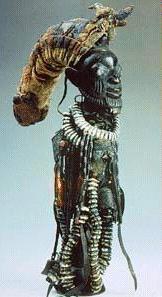
Lord of the roads and the beginnings.
Some roads/qualities:
Aluvaia, Jira – Kinãn, Jira – Lodo, Jira – Mavambo, Apavenã, Malele, Mavila, Sinzamuzila, Mavambo, Imbé, Berequete, Kijanjá
KIUÁ LUWAIÁ NGANANZILA KIUA (Long live Aluwaiá, Lord of the Roads)
NKOSI MUKUMBI
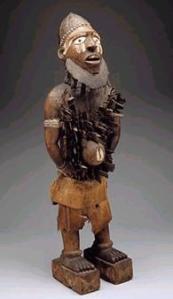
Nkisi of war, warrior and champion of social causes.
MIKAIA
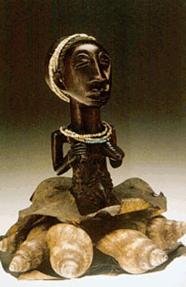
Mistress of the seas and oceans, the salt water. Considered the mother of all Mutuê (heads), protector of the family and takes care of keeping alive the concern and desire that the people around us are well.
KATENDE

Nkisi of medicinal herbs, leaves, healing through them. He has a vital importance in the rituals of Candomble Bantu. He has the profound knowledge of the secrets of the plants.
NZAZE

The sacred thunder, brings justice to humankind. The decision, will, initiative.
KINGONGO

Nkisi of the land in its interior, old warrior and fighter. Lord of pests and diseases. Lord of the cemeteries where he takes care of the remains of our ancestors. Merciful.
Some of his qualities or ways: Kavungo, Kafunán, Kafungê.
MUTAKALAMBÔ
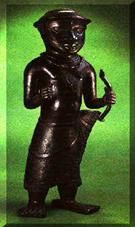
Nkisi of hunters, god of prosperity, wealth and abundance. Governs the material, social order, the administrative and the police as well. His features are wisdom, caution, contemplation.
Within Mutakalambô, a road is Nkongobila, a young hunter and fisherman.
KINDEMBU

Relates to chronological and mythological time. Nkisi of change. Nzara Ndembu! (Glory to Tempo!)
He is a divinity of powerful and constant mutation. Represented by a white flag, the flag of time.
Qualities:
apanga (autumn) - murunganga (Summer) - kapilecongo (winter)
- Miulo
- Amuraxó
- Mavila
- Mavulu
- Ekicikó
- Jabukangue
- Lembura
- Makuradile
- Evazile
- Zalu
- Apokan
- Polokun
NDANDA LUNDA

Lady of fertility and the moon.
KISIMBI
Mother of sweet waters, protects babies still in the womb. Rules love, curiosity, charm, and magic too. She is closely related to fertilization and the cell mater.
MATAMBA

Female Nkisi, owner of the sword, fire, passion. Queen and Lady of lightning storms, and powerful warrior. Responsible for Mvumbi (dead), guiding them with Nkisi Kingongo. She rules the desire of possession, jealousy, sexuality. Has influence in mental conduct, as well as in madness.
HONGOLO
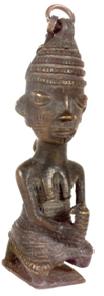
Hongolo or Angorô (male) and Angoroméa (female).
Helps with the communication between deities and humans. Represented by a colorful cobra. His/her main function is to direct the forces that produce motion, action and transformation. Dual nature.
NZUMBARANDÁ

The most feared of all Nkisi, the most respected, oldest, powerful and serious. She rules in swamps, in the mud, and death. She is close to the boundary between life and death. She was formed by the contact of water with earth.
WUNJI
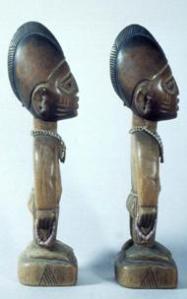
He is the child Nkisi, divinity of games, jokes. The joy of childhood. Wunji gives all the best, he always brings happiness.
LEMBA DILÊ
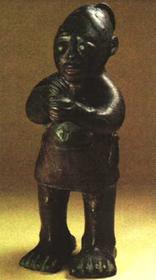
He is the positive side of universal balance. Understanding, balance and clarity. Pambu Njila begins all, Lemba ends all. Some roads are Nkassuté, Lemba Nganga, Kukurukaia.
Some interesting facts in regards to Initiation.
The ìyàwó is called the ndumbi, although the term ìyàwó is also used.
The ndumbi is secluded in the terreiro for 6 months, however the entire process to become a priest can take from 7 to 14 years.
The costs are around 7000 BRL = 3500 USD, this depends, of course.
This youtube video has very nice songs of Candomble de Angola. I am sure that those who are involved in Palo will recognize some terms.
I have noticed that the music of the atabaques in Candomble de Angola has a strong similarity to Dominican Palo music, which also has origins in the Bantu peoples.
Saudação aos Nkisi
http://www.youtube.com/watch?v=HlpZXbn-6x4
Interested in Books?
Learn Portuguese, then try to look to the one of the few (prolly the only one) books on Candomble de Angola. Very rare too.
Candomble de Angola by Tata Nitamba Tarengue.

If you can handle listening to Brazilian Portuguese, the following is a good and short two-part series on Candomble de Angola.
Redanda 1/2
http://www.youtube.com/watch?v=oVgMNV9FzIk
Redanda 2/2
http://www.youtube.com/watch?v=bxcQSC5RL7w
Isso é tudo!!!! Discuss!
